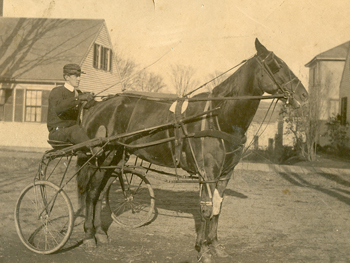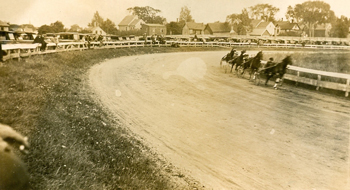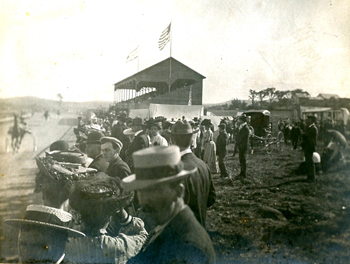Maine’s Trotting Parks
by Tom Seymour

Billy Wilkes driver, 1904. Owned and trained by L L Gentner raced by Henry Gentner. Courtesy Belfast Historical Society and Museum
During the early 19th century farmers in Maine had little time for recreation. But by mid-century, technological innovation made farming more efficient, which in turn allowed people to take breaks from their dusk-to-dawn labor. And since farmers, by virtue of necessity, owned horses, it was only natural to employ these animals in something other than work-related activities.
Thus was born the grand tradition of horse racing in Maine. While individuals may have participated in impromptu races, the growing number of people raising horses for racing rather than work dictated that some formal venue be established. This interest in horse racing began to grow at about the same time that agricultural fairs began popping up all over the state.
Vanishing Fairgrounds
And so Maine’s fairgrounds included not only buildings where people exhibited new, perfectly-shaped and sometimes giant vegetables and flowers, but also raceways. Many if not most of these racetracks and fairgrounds are long gone, but in numerous instances the outline of the oval raceways remain. Places where once hundreds upon hundreds of spectators cheered their favorite horses are now either turned into hayfields or building lots, an ignominious end for such wonderful and exciting pieces of Americana.
While not every town had fairgrounds or racetracks, a surprising number did. In fact so many raceways were open and running in the second half of the 19th century, that horse owners were able to go from one trotting park event to another, with little time left in between. At one time, more than 100 Maine communities owned or operated trotting parks. Owners of outstanding horses were able to profit by running in the fair circuit, going from one town to the next as summer changed to fall.
Another contributing factor to the popularity of trotting parks was the new and hopeful attitude of Americans coming out of the dark days of our Civil War. Returning soldiers and their families needed something to belong to, to feel good about. The country had changed. No longer did the world revolve around the vicissitudes of war. Just the opposite, in fact. People were ripe for a new life, a new way of living. No longer was rural life a never-ending barrage of hard work. People now either found or made time for recreation. Enter the grand sport of horse racing.
Just as those who follow harness racing today make it their business to know all there is to know about each participating horse, people in the late 19th and early 20th century were equally as informed. Horse racing was a universal pastime, both for those directly involved and also the legions of fans. Newspapers abounded in stories of remarkable horses. Classified ads included famed horses available for stud service. In short, horse racing was a dynamic and all-encompassing part of daily life.
While we today immerse ourselves in team sports such as football, baseball, hockey and basketball, our ancestors had an equal passion for horse racing. As an example of the popularity of horse racing, let’s look at a clipping from an undated late 19th century newspaper: “Wednesday afternoon occurred the two trots mentioned in our last number, the one for the Grand Sweepstakes of $300, and the other for horses that had never beaten 2.42. There had been a little rain in the morning, but the weather was pleasant in the afternoon and the track in very good condition, though a trifle heavy. A large crowd assembled to witness the races, and the grounds presented a lively appearance. The City Guards in their new uniform, with the Belfast Band at their head, were at the Park, and the former helped to keep the crowd from the track and preserve order, while the band enlivened the occasion with their music.”

Belfast Fair track, Belfast, Maine, 1904. Harness racing horses run at a specific gait either trot – left front leg with right rear and then right front leg with left rear, or pace – left front leg with left rear and then right front with right rear leg pulling a very light sulky cart. Courtesy Belfast Historical Society and Museum
Pearl Brook
Pearl Brook Farm in Belfast, Maine, was one of Waldo County’s most noted farms. In addition to being the only successful tobacco farm ever in Maine, the owner, Maitland B. Smith, also leased the old Dana’s Sarsaparilla building in Belfast and there manufactured from his own crops, 100-percent Maine-made cigars. Smith also excelled in raising racehorses and training horses for races. A flyer for Pearl Brook Farm for the 1906 season shows that Smith charged $40 per month to train a horse and prepare it for races, which was a considerable sum of money for the time. Smith also pastured brood mares and young stock for the sum of $3.00 per month.
That same flyer for Pearl Brook Farm also contains photos of some of Smith’s winning horses, the names of which were Marston C., Masconomo, Marvin and Brown B.
As an interesting aside, modern maps assign no name to the brook for which Maitland B. Smith named his farm. However, in days past hunting for pearls in freshwater mussels was not only a popular pastime, but also a potential moneymaker. Freshwater pearls are sometimes large and beautiful and often sold for goodly sums. Today, we know that many of our freshwater mussels are endangered and killing them in search of pearls is no longer countenanced. All the same, Pearl Brook must have yielded some fine pearls for the farm to be assigned such a name. We today are left to wonder if Smith was enabled to fund some of his ventures with money earned from selling pearls.
Speaking of horse names, while many were somewhat fanciful, others were named after heroes of the day. Consider, for instance, two trotters whose owners advertised for stud service. These were General McClellan and General Grant. General McClellan was, according to owner Horace McKenney, “…well known in this region as a well made and fast trotting animal, having taken the first premiums of the Waldo and North Waldo Agricultural Societies.”
As if to add more significance to General McClellan’s prowess, McKenney advertised that he would challenge, “…any stallion in the state, for $1,000 on a side, to compete with this horse, for two mile heats, one to be walked and one to be trotted.”
General Grant was no less celebrated. Owner Robert Patterson advertised his General as, “…five years old, iron gray, weighs one thousand lbs., of splendid style and action, and a very fast trotter. Altogether, no more promising young horse was ever offered for public inspection.”

Belfast Fairground race track. U.S. harness racing horses are standardbreds, so named because in the early years of the Standardbred stud book, only horses who could trot or pace a mile in a standard time of no more than 2 minutes, 30 seconds were admitted to the book. Courtesy Belfast Historical Society and Museum
Horses Today
With the advent of gasoline-powered farm equipment, trucks, automobiles and a drastically-reduced work schedule, Mainers and indeed most Americans, have little need of horses. Some equine enthusiasts keep horses for recreational riding, and that has spawned a cottage industry in the form of growing, harvesting, packaging and selling hay. What with houses springing up like mushrooms after a fall rain, hayfields are being sold for prices the old farmers who first cleared the fields never dreamed of.
But trotting and harness racing, while nowhere near as popular as it was a little more than 100 years ago, manages to live on. And while some local folk continue to raise horses for racing, the circuit itself has grown considerably smaller.
All the same, agricultural fairs and the accompanying horse racing and sometimes horse pulling (a contest where teams of animals compete to see which can pull the heaviest “sled” the farthest) continue as before and in fact, a whole new generation of fans look to these annual events with great anticipation. Such places as
Union Fair
www.unionfair.org/HarnessRacing,
Bangor Raceway
www.hollywoodslots.com,
Blue Hill Fair
www.bluehillfair.com,
Cumberland Fair
www.cumberlandfair.com,
Fryeburg Fair
www.fryeburgfair.com,
Northern Maine Fair
www.northernmainefairgrounds.com,
Oxford Fair
Skowhegan Fair
Topsham Fair
www.topshamfair.net and,
Windsor Fair
continue to delight fans and participants alike.
So while we no longer need horses, we still love them. The lure of the old-time trotting parks is strong and Stephen D. Thompson and his cousin Clark Thompson are both responsible for keeping the old times alive. Stephen maintains an online site called Lost Trotting Parks Heritage Center, www.losttrottingparks.com, and Clark has written a book called Maine’s Trotting Horse Heritage Trail. The book contains 21 significant monuments in Maine history related to the trotter and harness racing. He has also placed inscribed granite markers at each location. The book also provides directions to some of the old parks. Those interested in learning more about trotting parks, can contact Stephen D. Thompson, Creative Director, at lifework50@gmail.com.
The mission of Lost Trotting Parks Heritage Center is to “preserve the stories and images of the 19th century to present day that illustrate the history of Maine’s harness racing, lost trotting parks, fairs, agricultural societies, Granges, and the significance of the horse in society. Our plan is to reach our mission through Preservation, Education, Promotion and Partnerships.”
Persons interested in lost trotting parks might also contact their town’s historian, if there is one. Sometimes the sites of trotting parks are right out in the open, but no one recognizes them for what they once were. Did your Maine town have a trotting park? Chances are good that it may have.
To watch a harness racing video: https://en.wikipedia.org/wiki/Harness_racing.
